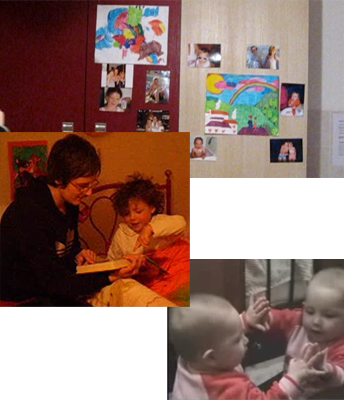Supporting personal identity development
 |
Each child should have a personal space.
This can be a part of the sleeping room or a personal chair where meals are served, also a bed or a box which only the child and the primary caregiver are allowed to open.
For babies and toddlers it can be a special personal object such as a teddy bear, a toy or perhaps a valued t-shirt or something else. Caregivers help the child protect the personal space and personal objects from being invaded by other children.
To support the baby/ toddler’s growing awareness of itself: play with mirrors, let the child hear its own voice on a tape recorder, or to let the child see itself on short video clips from daily activities is helpful. In this way the child can learn to be aware of itself and to understand how it affects others.
A photo of each child can be attached to their beds or in another place, and children’s names be written in bright coloured letters.
For toddlers and up: each child can have a diary book. Every day you talk to the child about what happened today or what it is interested in, and write it down while the child is watching. If you are short of staff or time, this can be a group activity where the children take 3 minute turns in telling about their day.
Occasionally you can take pictures of the child’s activities and place them in the book. Any information about the child’s relatives is also discussed with the child and noted. |
|
The primary caregiver can talk to the child about what is special and personal in its behaviour, in the way it relates to others in the group, and what special talents or gifts the child seems to have. With the child you can regularly measure physical developments – you can for example let the child stand against the wall and use a pencil to write on the wall how tall the child has grown every 3 months.
Pre-school children and schoolchildren also have another personal space that should be planned for: the right to be alone sometimes, without having to interact with other children or caregivers. For children with behaviour problems it can be very exhausting to be in a relation all the time, and instead of isolating them because they are disobedient, regular short pauses where they can be alone can prevent many social problems. This can be while the child does school homework or wherever you think there is a natural opportunity. |
|
“We have created a chart on the wall and it worked very well. For each one of them we created a memory box. Photos, clip art papers, Shoes and so on. It is so much fun and sometimes, sad.”
Staff member’s statement
CHECKLIST FOR UNDERSTANDING
- Why do children placed outside home often develop low self-esteem and feelings of homelessness?
- How can you support personal identity development in the way you work with children and the way you arrange their personal space?

 English
English






